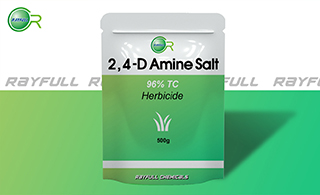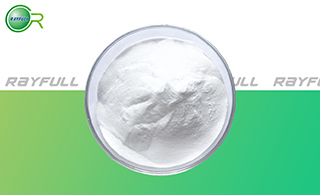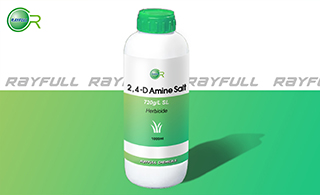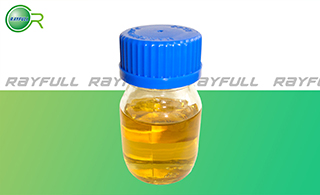2,4-D Amine Salt
    2,4-өО°·СО 2,4-өО°·СО
Introduction: 2,4-D Amine Salt is a selective systematic post emergent herbicide. It is in liquid state and does not require long time for stirring. It is fully soluble in all proportions and therefore is well adopted to low gallonage spray equipment, even at high rates of application. It is a safe herbicide in connection with accumulation in soil and phytotoxicity. Being highly soluble in water it leaches more faster than the mineral salts of 2,4-D and is then absorbed by the soil organic matter or clay colloids.
Common name: 2,4-D Amine Salt
Another name: 2,4-D dimethylamine salt; Aminol; 2,4-D-Dimethylammonium; Amicide; Herbitex; etc.
Chemical name: dimethylammonium (2,4-dichlorophenoxy)acetate
Empirical formula: C10H13Cl2NO3
Structural formula:

Mol. Weight: 266.12 g/mol
CAS No.: 2008-39-1
Specifications
Leading 2,4-D Amine Salt supplier
2,4-D Amine Salt 96% TC
2,4-D Amine Salt 860 g/L SL
2,4-D Amine Salt 720 g/L SL
Packing:
BULK PACKING
Powder: 25kg/Bag, 25kg/Drum, 50kg/Drum etc.
Liquid: 200L/Drum, 20L/Drum, 10L/Drum etc.
SMALL PACKING
Powder: 1kg/Alu bag, 500g/Alu bag, 200g/Alu bag, 100g/Alu bag, 50g/Alu bag, 15g/Alu bag etc.
Liquid: 5L/Drum, 1L/Bottle, 500ml/Bottle, 250ml/Bottle, 100ml/Bottle, 50ml/Bottle etc.
Customerized packing label
2,4-D Amine Salt FAO standard
Professional registration
HAZARDS IDENTIFICATION
Hazard statement(s)
H302 (100%): Harmful if swallowed.
H312 (21.58%): Harmful in contact with skin.
H317 (100%): May cause an allergic skin reaction.
H318 (100%): Causes serious eye damage.
H332 (21.58%): Harmful if inhaled.
H411 (100%): Toxic to aquatic life with long lasting effects.
Precautionary statement(s)
P261: Avoid breathing dust/fume/gas/mist/vapors/spray.
P264: Wash ... thoroughly after handling.
P270: Do not eat, drink or smoke when using this product.
P273: Avoid release to the environment.
P280: Wear protective gloves/protective clothing/eye protection/face protection.
P301+P312: IF SWALLOWED: call a POISON CENTER/doctor/... IF you feel unwell.
P304+P340: IF INHALED: Remove person to fresh air and keep comfortable for breathing.
P305+P351+P338: IF IN EYES: Rinse cautiously with water for several minutes. Remove contact lenses if present and easy to do - continue rinsing.
P310: Immediately call a POISON CENTER or doctor/physician.
P321: Specific treatment (see ... on this label).
P330: Rinse mouth.
P333+P313: IF SKIN irritation or rash occurs: Get medical advice/attention.
P363: Wash contaminated clothing before reuse.
P391: Collect spillage.
P405: Store locked up.
P501: Dispose of contents/container to an approved waste disposal plant.
Supplemental Hazard Statements: none.
MAMMALIAN TOXICOLOGY
Acute toxicity: 1) Acute oral LD50 for rats is 300-2000 a.i.mg/kg. 2) Acute dermal LD50 for rats is >2000 a.i.mg/kg. 3) Acute inhalation toxicity LC50 (4 h) for rats is >5.06 a.i.mg/L. 4) Skin irritation: Non-irritating to skin (rabbits). 5) Eye irritation: Non- irritating to eyes (rabbits). 6) Skin sensitization for guinea pig: Not sensitising.
ECOTOXICOLOGY
Effect on birds: Acute oral LD50 for Mallard is >5620 a.i.mg/kg. Effect on fish: Acute LC50 (96 h) for Rainbow trout is 100 a.i.mg/l. Effects on aquatic invertebrates: Acute EC50 (48 h) for Daphnia magna is >100 a.i.mg/l. Effects on algae: Acute 72 hour EC50 for Pseudokirchneriella subcapitata is >60.7 a.i.mg/l.
ENVIRONMENTAL FATE
If released to air, an estimated vapor pressure of 2.3ЎБ10-9 mm Hg at 25Ўж indicates 2,4-D dimethylamine will exist solely in the particulate phase in the ambient atmosphere. Particulate-phase 2,4-D dimethylamine will be removed from the atmosphere by wet and dry deposition. If released to soil, 2,4-D dimethylamine is expected to have high mobility based upon a range of Koc values from 72 to 136. Volatilization from moist soil surfaces is not expected to be an important fate process based upon an estimated Henry's Law constant of 1.4ЎБ10-16 atm-cu m/mole. Biodegradation is the primary degradative pathway in the soil with half-lives ranging from 4-6 days and 7-23 days in agricultural and forest soils, respectively. If released into water, 2,4-D dimethylamine salt is not expected to adsorb to suspended solids and sediment based upon the Koc. In a river-die away study, a half-life of 3.9 days was obtained for an unspecified amine salt of 2,4-D. 2,4-D dimethylamine is rapidly degraded by aquatic microorganisms in activated sewage. Volatilization from water surfaces is not expected to be an important fate process based upon this compound's estimated Henry's Law constant.
Usage: 2,4-D Amine Salt was covered in The Hormone Weedkillers, C. Kirby. It is a translocated phenoxy herbicide for use in cereals, grass and amenity use.
Application: Biochemistry Synthetic auxin (acting like indolylacetic acid). Mode of action Selective systemic herbicide. Salts are readily absorbed by the roots, whilst esters are readily absorbed by the foliage. Translocation occurs, with accumulation principally at the meristematic regions of shoots and roots. Acts as a growth inhibitor. Uses Post-emergence control of annual and perennial broad-leaved weeds in cereals, maize, sorghum, grassland, established turf, grass seed crops, orchards (pome fruit and stone fruit), cranberries, asparagus, sugar cane, rice, forestry, and on non-crop land (including areas adjacent to water). Control of broad-leaved aquatic weeds.
| 






